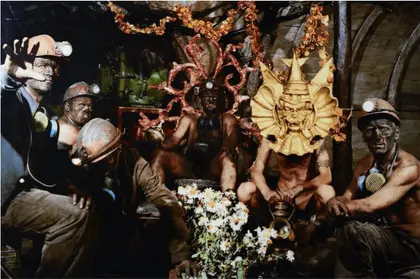Galleries at the Cromwell Place art hub in London will from March 30 to April 8 feature an exhibition of Ukrainian contemporary art “Phoenix Rising.” Its curators, Forsa Gallery founder Elis Nananova and artist Pavlo Kerestey, will present the works of Ukrainian artists of multiple generations. Among them are Arsen Savadov, Tiberiy Silvashi, Artem Volokitin, Roman Mikhailov, Maria Kulikovskaya and Oleg Vinnichenko, Valeria Trubina, and Yulia Belyaeva.
JOIN US ON TELEGRAM
Follow our coverage of the war on the @Kyivpost_official.
Today, the world is discovering the culture of Ukraine, a country that has debunked the myth of Russia's invincibility and greatness. The response of Ukrainian artists to the escalation of war, united with the cohesion of society and the government, affirms our national mindset. Its persuasiveness is manifested in the polyphony of voices, united in the conviction of their right to freedom and dignity to be themselves.
Abstract light.Water
Ukrainian art confronts the Kremlin tradition of collectivization - the depersonalization of human beings by the government - turning them into tiny “cogs” in the authoritarian machinery.
Ukrainian culture had spent centuries in the shade of the Russian imperial project. The tsarist official doctrine about “three nations - three brothers” was an attempt to say Ukrainians and Belorusians were the same as Russians, with only regional differences. Despite declarations about equality and the right to self-determination, the soviet definition of “brotherly nations” emphasized that Russia was, importantly, the “eldest brother.”
What Ukraine’s New Law on Religious Organizations Means
The history of Russia’s censorship of and prohibitions against Ukrainian culture dates to the seventeenth century - before the union of the Cossack state with Moscow led by Bohdan Khmelnytsky.
Pavlo Kerestey
The destruction of Ukrainian books and persecution of printers were implemented by the founder of the Romanov dynasty, Moscow Patriarch Filaret, and his grandson, Tsar Alexei Mikhailovich.
Andrei Sakharov, the Nobel Peace Prize winner, wrote about Stalin's Ukrainophobia. He also drew the world's attention to Ukrainian dissidents who were persecuted by the Soviet government.
Ukrainian poet Vasyl Stus died in a Soviet camp even under Gorbachev’s rule in 1985.
After each wave of repressions, Ukraine's own cultural tradition was reborn like a Phoenix.
It was nourished by the mutual influences of different nationalities that coexisted on Ukrainian territory, the wealth of natural resources, and historically formed individualistic and egalitarian attitudes.
Today's solidarity in Ukrainian society is based on the customary understanding of borders: personal, social, and proprietary.
After the restoration of Ukraine's independence, it turned out to be impossible to build a paternalistic regime here.
It is worth noting that the first attempt to realize an anarchist utopia, led by Nestor Makhno, happened in Ukraine in the early twentieth century.
Yury Musatov. Explosion
“To every city its customs and laws, to each head its own thinking” - these words from the song of the eighteenth-century Ukrainian philosopher and educator Hryhorii Skovoroda are sure to resonate with the freedom-loving British mindset.
Confidence in the inalienability of the right to freedom to be oneself and to overcome the trauma of barbaric violence is manifested in the works of the Ukrainian artists of the Phoenix Rising project.
Created by artists of different generations in different styles and media, they, like the entire struggle of Ukraine today, give life and blood to values that until recently seemed universal but were undermined by the savage Russian attack.
This is the past attacking the present.
We must overcome it together and forever, never again to expose civilization to the challenge of the tragic fate of a Phoenix.
The money raised by the exhibition will go toward financial assistance to Ukrainian academic programs, grants, and UK residency programs for Ukrainian artists.
You can also highlight the text and press Ctrl + Enter







